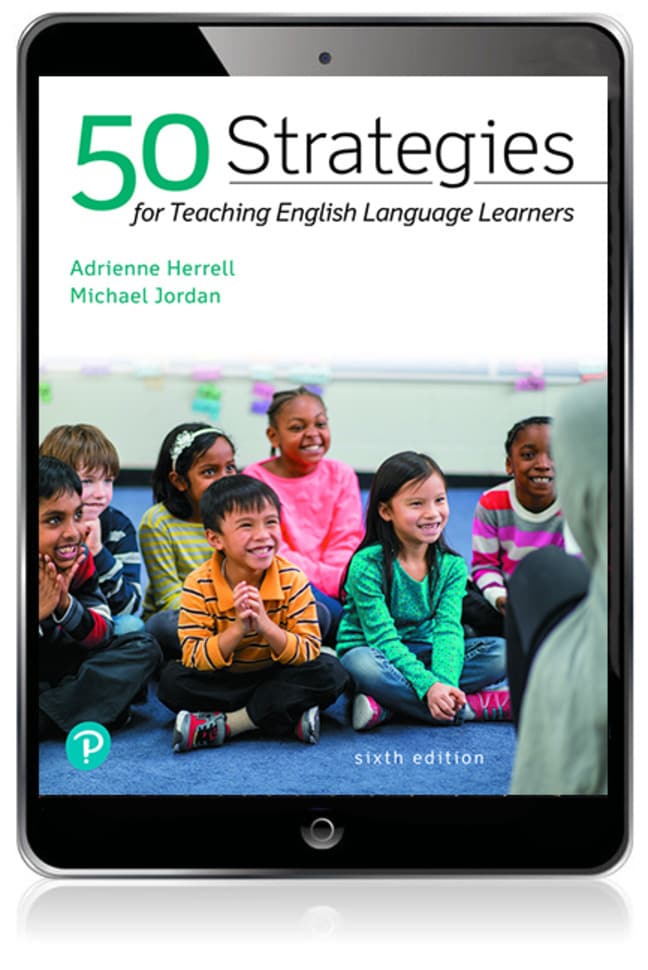
50 Strategies for Teaching English Language Learners, 6th edition
- Adrienne L. Herrell
- , Michael L. Jordan

- Study simpler and faster
Use flashcards and other study tools in your eTextbook
- Watch and learn
Videos & animations bring concepts to life
- Listen on the go
Learn how you like with full eTextbook audio
- Find it fast
Quickly navigate your eTextbook with search
- Stay organized
Access all your eTextbooks in one place
50 Strategies for Teaching English Language Learners offers an assortment of practical strategies aligned to TESOL standards, which have been field-tested in diverse classrooms. For each strategy, the text provides a brief explanation, step-by-step instructions on how to plan and use the strategy and classroom scenarios demonstrating how the strategy can be adapted for different grade levels and content areas. The authors have included additional strategies in language and literacy development, technology, and assessment to support both pre- and in-service teachers.
The 6th Edition includes a new chapter on the choice and use of technology strategies based on students' unique needs, additional adaptation charts, and expanded teacher self-evaluation rubrics.
Published by Pearson (September 18th 2020) - Copyright © 2020
ISBN-13: 9780136616252
Subject: Multilingual/English Learners
Category: Teaching English Learners
1. Predictable Routines and Signals: Reducing Anxiety
2. Total Physical Response and Total Physical Response Storytelling (TPR and TPRS): Integrating Movement into Language Acquisition
3. Modeled Talk: Demonstrating as You Talk
4. Visual Scaffolding: Providing Language Support through Visual Images
5. Realia Strategies: Connecting Language Acquisition to the Real World
6. Vocabulary Role-Play: Building Vocabulary through Dramatization
7. Collecting and Processing Words: Making Vocabulary Your Own
8. Manipulatives Strategies: Using Objects to Connect Concepts
9. Choosing Technology Based on Student Needs: Advancing Progress in English Language and Content Learning
10. Moving into Reading: Using Multiple Strategies to Foster Comprehension
11. Close Reading: Engaging with Text to Improve Reading Comprehension
12. Repeated Reading: Using Script Writing and Reader's Theater
13. Scaffolding English Writing: Matching Instruction to Language Development
14. Reporting Back: Verbal Practice in Curriculum Connections
15. Leveled Questions: Adjusting Questioning Strategies to the Language Levels of Students
16. Bilingual Books and Labels: Supporting Biliteracy Awareness
17. Sorting Activities: Organizing Information into Categories
18. Cloze: Using Context to Create Meaning
19. Verb Action: Teaching Irregular Verbs through Experience
20. Syntax Surgery: Visually Manipulating English Grammar
21. Checking for Understanding: Using Questioning Strategies to Differentiate Instruction
22. Learning Centers: Extending Learning through Hands-On Practice
23. Communication Games: Creating Opportunities for Verbal Interaction
24. Cognate Strategies: Using the Home Language to Support English Acquisition
25. RTI for English Language Learners: Documenting and Monitoring Student Progress and the Effectiveness of Intervention
26. Preview/Review: Building Vocabulary and Concepts to Support Understanding
27. Story Reenactment: Making Stories Come to Life!
28. Repetition and Innovation: Exploring a Book to Deepen Comprehension
29. Language Focus Lessons: Supporting English Vocabulary and Structure Acquisition
30. Graphic Organizers: Visually Representing Ideas, Text, and Connections
31. Advance Organizers: Getting the Mind in Gear for Instruction
32. Guided Reading: Providing Individual Support within a Group Setting
33. Cohesion Links: Understanding the Glue That Holds Paragraphs Together
34. Language Framework Planning: Supporting Academic Language and Content Acquisition
35. Free Voluntary Reading: Nothing Helps Reading Like Reading
36. Culture Studies: Learning Research Skills and Valuing Home Cultures in One Project
37. Microselection: Finding Key Words and Main Ideas
38. Read, Pair, Share: Working with a Partner to Negotiate Meaning
39. Attribute Charting: Organizing Information to Support Understanding
40. Integrated Curriculum Projects: Using Authentic Projects to Integrate Content Knowledge
41. KWL and Data Charts: Researching and Organizing Information
42. Collaborative Reading: What to Do When They Can't Read the Textbook
43. Cooperative Learning: Group Interactions to Accomplish Goals
44. Learning Strategy Instruction: Acquiring Self-Help Skills
45. Multiple Intelligences Strategies: Teaching and Testing to Student-Preferred Learning Modes
46. Multimedia Presentations: Oral Reports for the New Millennium
47. Small Groups and Partners: Interactions to Enhance Instruction
48. GIST: Exploring Tough Text
49. Tutorials: Closing the Achievement Gap
50. Combining and Scheduling Strategies: Supporting Learning through Differentiation